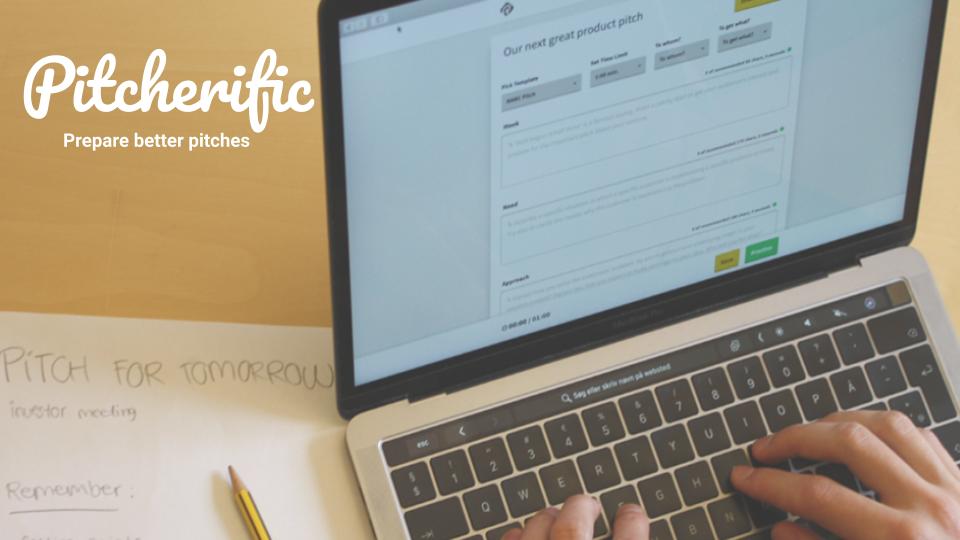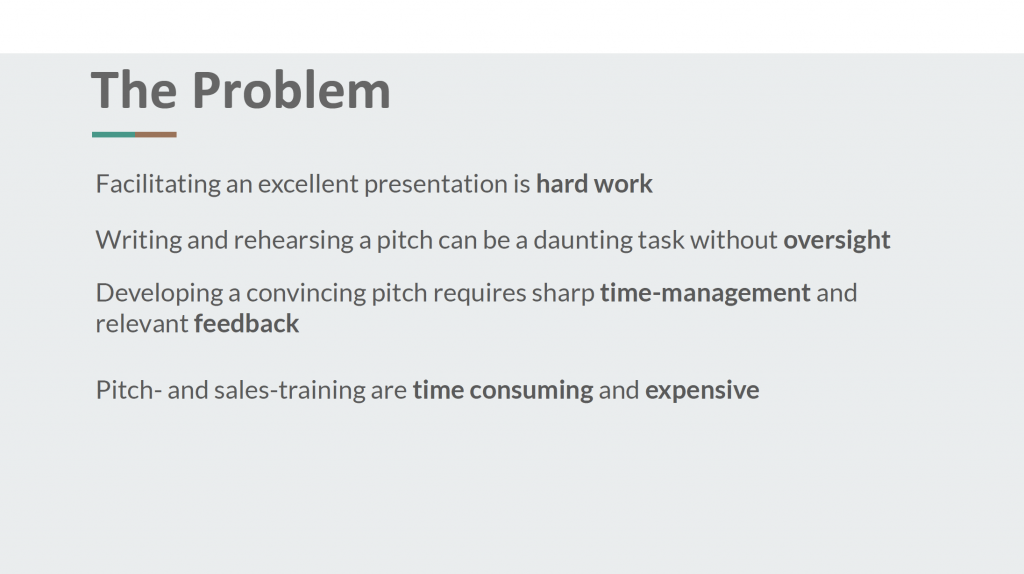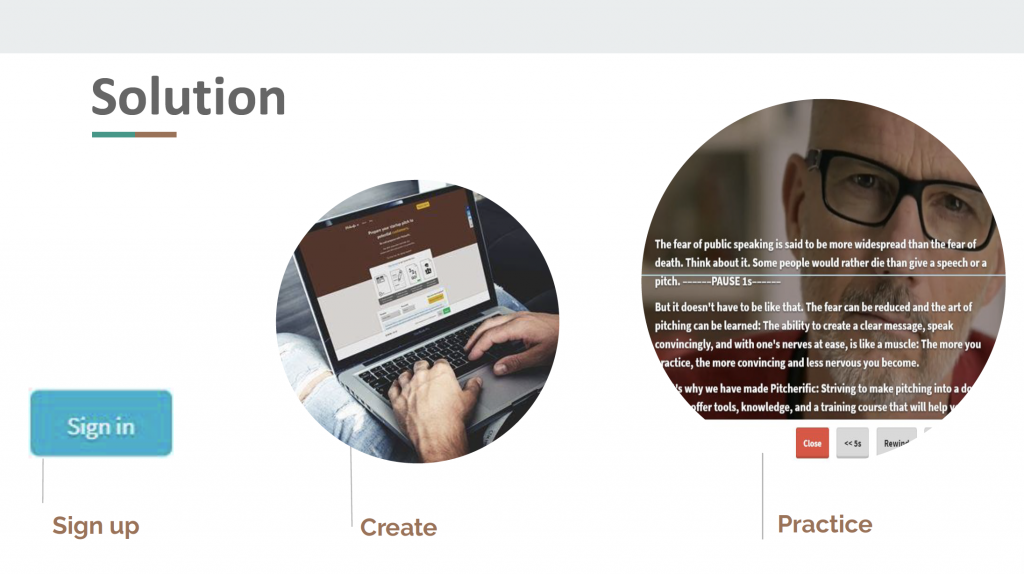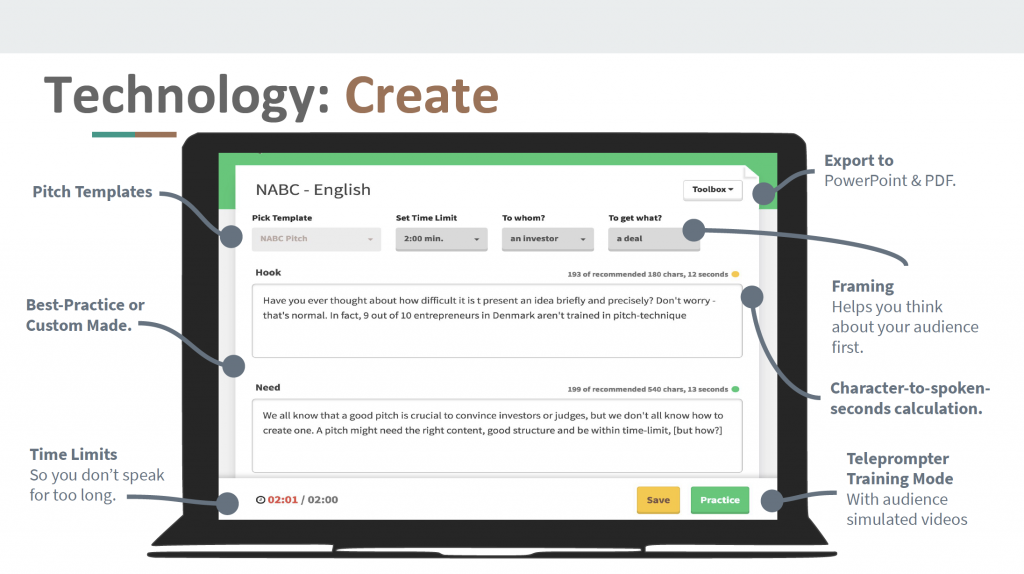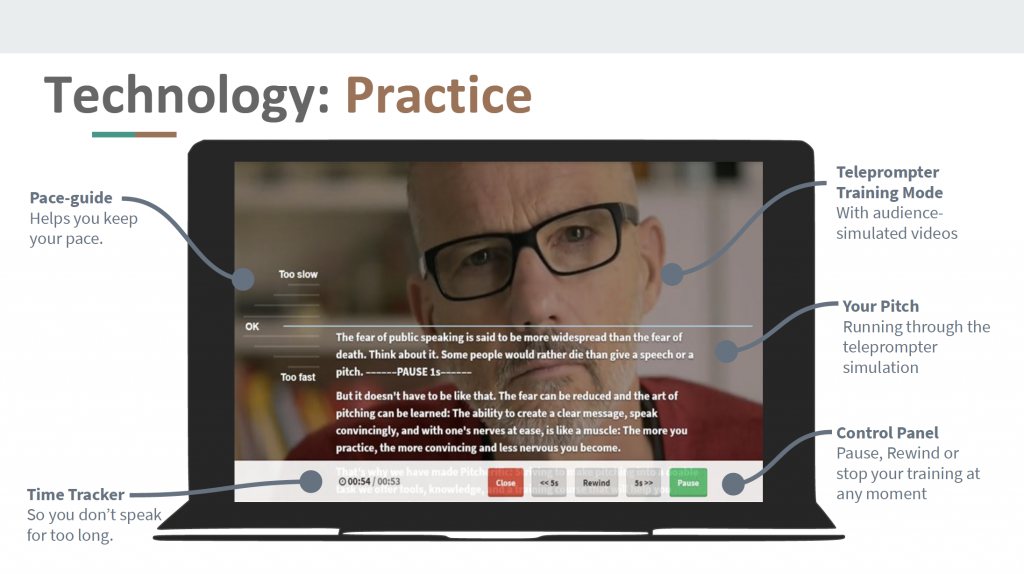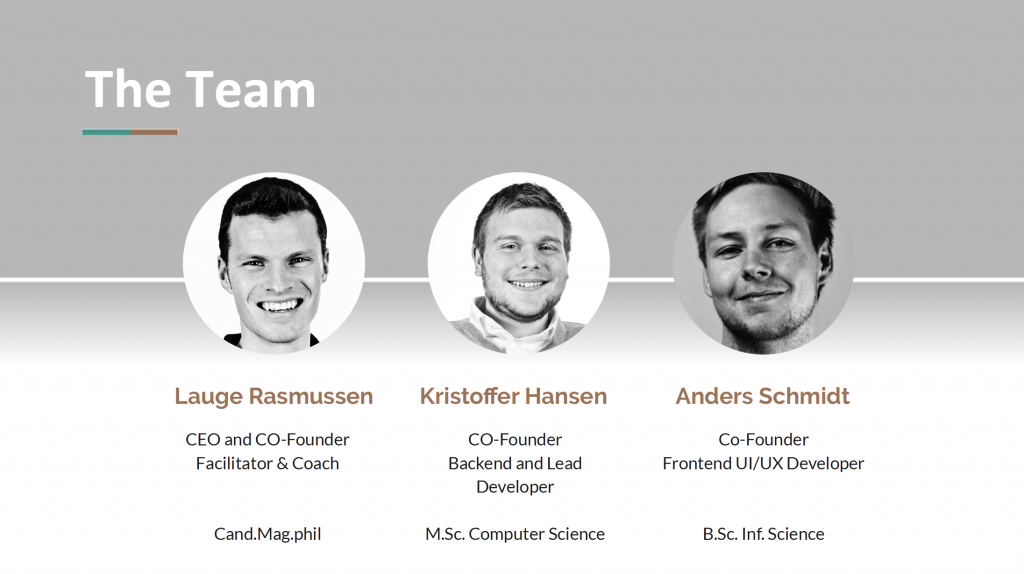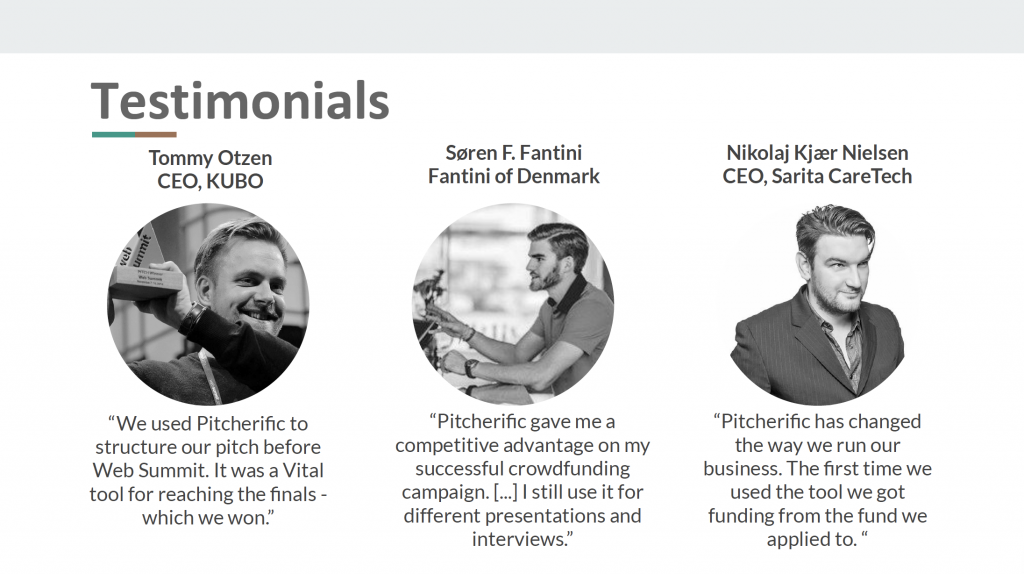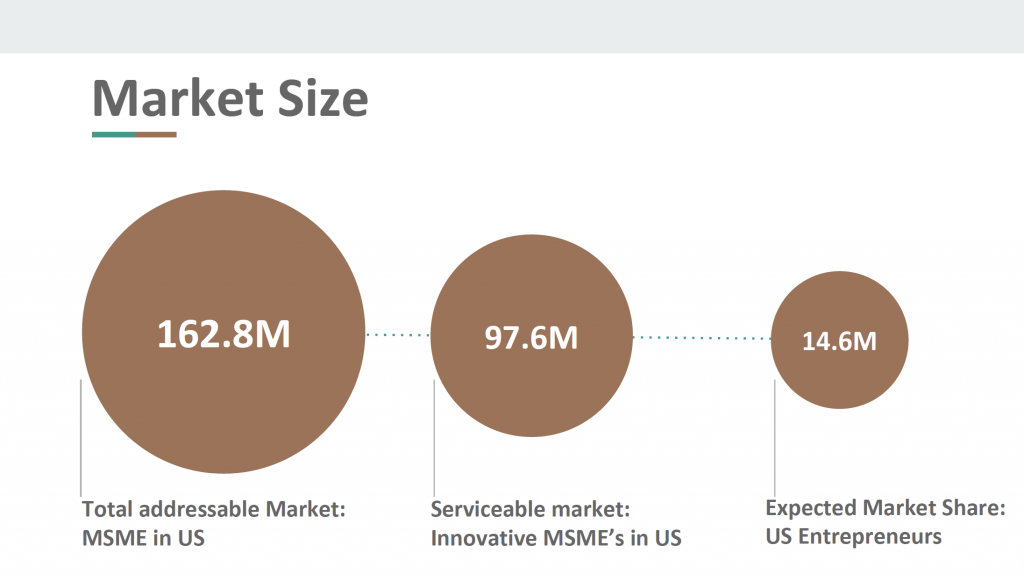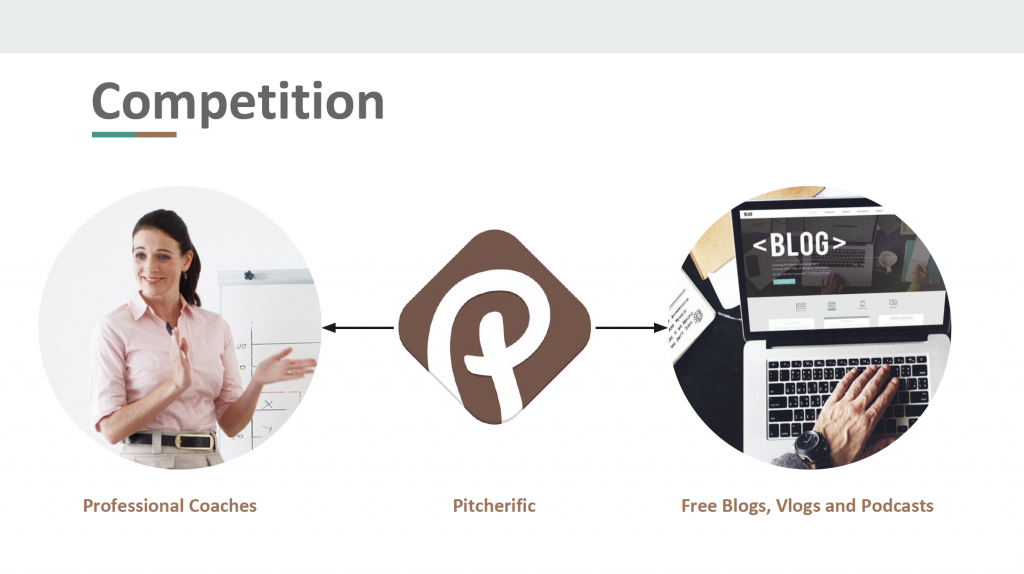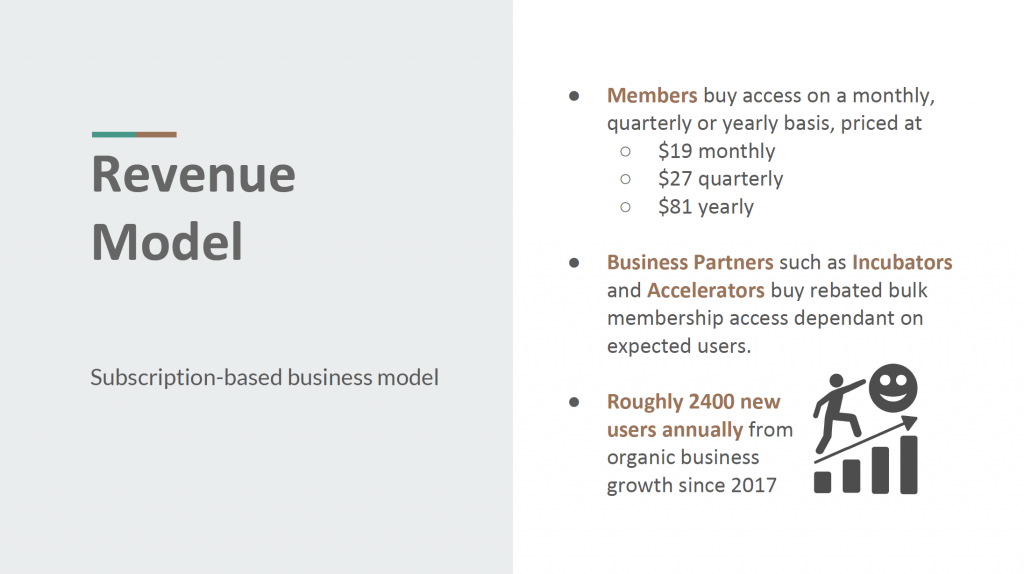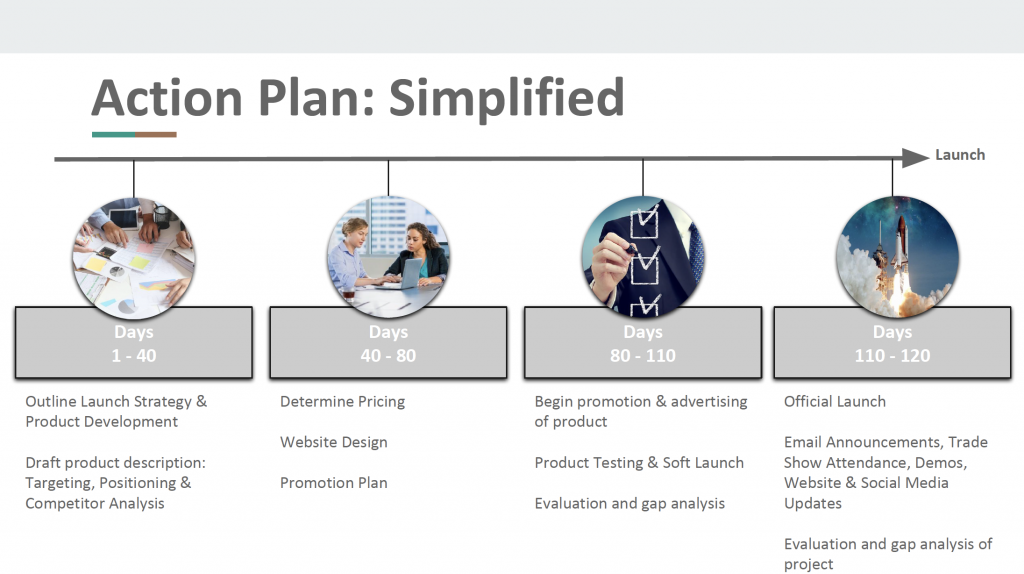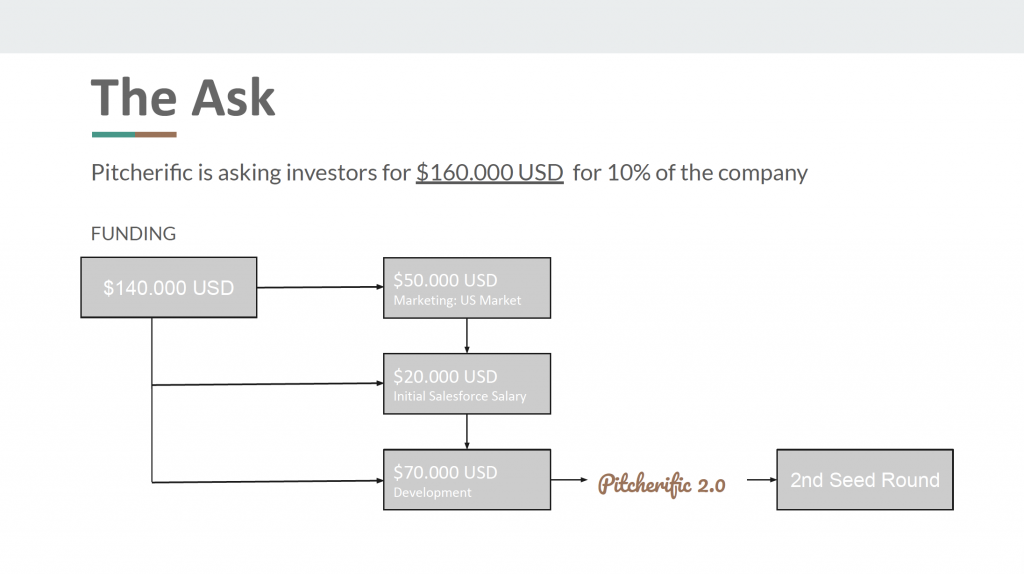Got an investor pitch to prepare?
In this article I’ll go over the in-depth investor pitch and what it contains, by showing you Pitcherific as an example, alongside what’s to be explained orally, as well as how long it would take using the Pitcherific tool for measurement. And don’t worry, I’ll make sure you know what slides are optional, and which are mandatory for a bare minimum of a presentation.
An investor pitch contains the following:
- The Hook
- Problem
- The Solution
- The Product
- The Technology
- Company Overview: Team
- Milestones
- The Market Opportunity
- The Competition
- Business Model / Traction / Financials
- Action Plan / Marketing Plan / Launch Schedule
- The Ask
- Call to Action / Appendix
Whew! That’s a lot to cram into a four minute presentation, isn’t it? Yes! So always take the time limit into account and cut to the bone wherever you can. But don’t worry, the bare minimum of this investor pitch-template can be presented in five minutes.
I made a slide deck to follow this article. Feel free to make your own slides directly from the example of the Pitcherific investor-pitch. You can find the slidedeck template right here.
First slide:
Slide 1: The Hook
- Optional (But recommended)
At Pitcherific we believe that less is more. Adding more than necessary only adds to confuse your audience. Let’s avoid that by not putting our hook in text on a slide deck, and just say it in a single sentence instead. So, our first slide doesn’t feature any text, just a company-logo, and a presentation:
“The fear of public speaking is, to many people, larger than the fear of death itself. The same can be said for entrepreneurs.
Seven out of ten new entrepreneurs have never received any formal training in pitching, despite it being crucial to their success. And there are millions of entrepreneurs worldwide who depend on being able to present their business quickly and concisely. At Pitcherific we help them do just that.”
Time: 25 seconds.
And that’s the hook established. We recommend you add a hook. It doesn’t have to take more than 15 seconds to establish, and it’s a good placeholder for that boring run-of-the-mill presentation.
Next slide:
Problem
- Mandatory
Present the problem or pain point that your product / service will solve. What is the current situation? What type of person suffers? What organisations are already involved and why aren’t they solving it? Remember to create urgency in your audience, by being specific and visualizing the pain points for your audience.
In keeping with the less is more mantra, let’s go ahead and make it easy for our audience to focus on what we’re about to tell them by only presenting one problem at a time. Do so by highlighting the important keywords that you want your audience to latch on to, and if there’s more than one sentence of text on a single slide, animate them so that only one is visible at a time so your audience can pay attention to what you’re saying while you’re saying it. Like so:
Presenting your problem(s) one at a time, gives you the ability to freestyle a little as long as you mention your keywords. You can go in depth with a specific problem to a specific audience, or you can quickly glance over it if you feel the need to do so.
“Facilitating an excellent presentation is hard work. It’s even harder if you’ve never done it before, and it gets specifically harder when you have to present something that you hold dear: Your business, your product, your livelihood.
It’s hard because you lack oversight. You don’t know where to begin, where to end, when to change the subject or how you create a natural flow between your subjects, and you might fail to notice on your own.
And developing a convincing pitch requires sharp time management, a lot of training and relevant feedback, but how do you know how long you’ll be speaking for, how do you manage your pace and staying on time? Should you rehearse with a stopwatch? And if you’re not on time, how will you know what part of your presentation is taking too long to get through?
You can’t just go buy a pitch-trainer to solve all your problems, as they’re both time-consuming and expensive, and you need to be ready for this presentation in just two days. Will you be able to convince your client, or secure the investment you’ve been working towards for the past six months?”
Time: 65 seconds.
Remember to create a common understanding between you and your audience, of what the consequence is if this problem goes unsolved, and end on the solution to this being important.
Que your product:
Solution
- Mandatory
Your product should be easily explained in such a way that it doesn’t appear to be a problem in and of itself to apply it. Try to simplify your product in such a way that it appears to be plug and play. Don’t worry if you can’t though, everyone loves things that come in threes, so a three-way explanation slides equally easily into your audience’s understanding.
Now, in the case of Pitcherific – which is a SaaS and therefore not a Plug&Play solution – some explanation is required, so we’ve added two slides that explain the technology. Because there will be some text on the slides, we use a Logitech Presenter to guide the audience while we present:
Make sure that you give your audience a hook to latch onto when you present your solution, and that you do it in the simplest of ways. Touch on all of the pain points you’ve set up so that it sounds almost too good to be true, yet non-debatable whether or not you truly are the one to solve the issue. Project confidence by boasting a little while you present.
“With Pitcherific users can choose between best practice templates, or create a pitch from scratch following their own unique wants and needs.
The Pitcherific time-checking software keeps track on how long it will take to present the pitch, and at any time the user can switch between practicing their pitch in our simulation-software, or return to the edit-session where the tool will give suggestions on how the pitch can be tweaked to perfection.
If the user gets stuck along the way, they can request professional feedback on their pitch from a live pitch coach. And all of this will on a yearly basis cost the user the same as a single hour-session with a professional pitch coach.”
Time: 45 seconds.
Short, concise, straight to the point. Doesn’t linger on specifics, but touches on all the pain points presented in the problem-slide within a minute. Incidentally, this is my own elevator pitch rewritten for the purpose of presenting it to a larger audience who has never heard of Pitcherific before.
Next slide:
Company Overview: The Team
- Mandatory
Investors don’t just invest in a product and a business, but also in your team. It’s not unheard of that angel investors will make startups perform team building-eque tasks for them before they invest, to see how well they coordinate or work together and if there’s anyone in the team who could potentially flip their investment the wrong way.
The Company Overview can be put first, last or wherever else you feel comfortable presenting your team. However, it is helpful for your audience to have it in the beginning, as it gives your audience a summarization of who you are, and it builds credibility towards your audience.
Whatever you do, don’t start presenting your team’s personal details. Nobody cares if you play soccer or like to go hiking in your spare time unless you’re selling soccer- or hiking equipment. Stick to professional titles and skills and mention any immediate networks or business partners that are an essential part of your business.
Your team-slide should look something like this:
Presenting the slide would sound something like this:
“Pitcherific is Located in Aarhus, Denmark, and consists of * Lauge, CEO and CO-Founder. Lauge is the genius behind the Pitcherific story. He has a blend of professional skills within presentation and pitching, and has a unique vision for the pitch training community standard. * Kristoffer Hansen, CO-Founder and Software Pilot at Trifork, is our Lead Developer * Anders Schmidt, CO-Founder and Frontend UI/UX Developer, makes sure that the Pitcherific tool stays at the highest of standards at all times. * Chris Overgaard, PR and Facilitator, handles outbound contact and does a minimal amount of marketing on the side.”
Time: 39 seconds.
Optional: If time permits, also present your business partners maybe even some combined efforts, just to show that you can in fact work together, or that others are backing you already:
“The combined efforts of the team has seen over 12.000 concurrent users, we’re part of an advisory board consisting of CEO’s from Restudy and Firtal-Group, and we have already partnered with several major incubator-hubs worldwide to see the trend continue.“
Time: 16 seconds.
On a side note: A lot of investor slide decks that I’ve seen feature serious-looking people wearing shirts and looking very business-esque. That’s not hot. Just look natural.
In regards to your picture I always recommend using professional photos. But you should try to use the best picture as well, and by best I mean the one with the biggest smile on it. Smiles are infectious, and you want your target-audience to latch onto that enthusiasm and feel your drive at every given opportunity.
Next slide:
Milestones
- Optional
If you’ve just started out and you’re trying to sell someone on the idea of your business, then having milestones might not be something you have. And that’s fine because this one is totally optional.
But if you do have anything to brag about such as, progress endorsements, competitions or prizes in general – anything you’re proud of – then I suggest you do so. You can do this in a number of ways through timelines, graphs, quotes, endorsements etc. The sky is your limit. I only ask that you stick to one thing. In this case I went with testimonials:
“At Pitcherific we have worked close with thousands of entrepreneurs over the past five years, and their success is our success. We have helped catapult startups to the top in Pitching Competitions, Crowdfunding Campaigns and Investment Rounds. And we’re proud to go to work every single day, helping others achieve their dreams”
…And then I’d read one of the testimonials aloud, taking full credit for their success.
Time: 45 seconds.
No nice words were ever said about a braggart, but like the american poet and journalist Walt Whitman once said:
“If you did it, it ain’t braggin”.
Next slide:
The Market Opportunity
- Mandatory
Now, with all the formalities and nonsense out of the way, it’s time to get down to brass tactics: Making an investor interested in your business, not just the idea.
Essentially it all comes down to one thing; Numbers, and this is where you really have a chance to foster some interest, and make those dollar signs flash in any investor-eye. Show the investor how large the entire market is, how large a piece of that pie you expect to be taking.
If you’re scratching a niche-inch then be honest about it. If you’re eyeing a prize that’s massive then shout it from the rooftops:
Presenting this slide would sound something like this:
“We take great comfort in knowing that the Organization for Economic Cooperation and Development (OECD) estimates that roughly 60% of the worlds newly founded Micro, Small and Medium (MSME) enterprises are innovate, meaning that in the US alone, there’s 97 million potential customers, of which a 15% estimated market share – which is what we’re aiming for – puts us at 14 million potential customers, and that’s in the US market alone.”
Time: 26 seconds.
I’d always encourage a reasonable number as the market share, as I expect anyone around me to be a sceptic, which is why I’ve included the total market, deducted 40% of the initial number as initial casualties outside of our reach, and then another 85% of that number to match only our core customers without fear of counting anyone who doesn’t fit our personas. I suggest you do the same.
Next slide:
The Competition
- Mandatory
Here’s where we need to get real. Because even if Pitcherific has a massive potential market reach, that doesn’t mean that there’s no specific competition we have to share it with. And nobody is sailing on a blue ocean of opportunities by themselves, no matter how special their product is.
Show the investor who your competition is, and set yourself up as the outlier who can either disrupt or change the entire business because of your product. Be honest, and don’t be afraid to set up the competition for what it is: established.
Now, Pitcherific has one major advantage and one major disadvantage: It’s a one of a kind product, meaning that piercing the thin veil of public consciousness is hard without a massive marketing presence. On top of that we won’t succumb to bait-like sales tactics promising immediate results and one-size-fits-all-workshops. And our blog posts aren’t constructed around keywords and clickbait like most other high-ranking blog posts are.
Instead we offer 24/7 availability on our training platform from the comfort of your home, 365 days a year, as a better valued alternative to traditional pitch coaching at way below the price. Meaning that you can practice your pitching anywhere at any time.
The presentation would then sound something like this:
“Pitcherific is far from the only provider of pitch-coaching service for entrepreneurs wanting to improve upon their presentation skills.
Pitch Trainers and Coaches offer coaching, workshops, or expensive personalized training sessions to those customers in their immediate orbit. And following the coaches are a myriad of blogs, vlogs and podcasts offering a vast amount of free knowledge in the field.
Pitcherific caters to the people that know knowledge is important, but training is key and people who know coaching is great, but often expensive and not a replacement for training.
Our offer stands in stark contrast to what’s currently being offered: Pitcherific provides an online training software with 24 hours availability alongside built-in knowledge and guides and a feedback option, at a yearly cost of less than óne coaching session, making us highly competitive.”
Time: 58 seconds.
Notice how I acknowledge that we’re not a golden goose, but don’t sell our own product short? That’s how you should present your competition as well. Acknowledge your competitors and upsell yourself. Focus on the positive aspects where you stand out, and let your investors know that you can compete or disrupt your expected market share.
Next slide:
Market Validation
- Optional
A market validation comes in different formats. You’ve either done some legwork in the form interviewing your potential customers, or you have actual proof that you can make your business work because you already have customers. Either way, it’s not a mandatory slide to include, but it’s up there alongside nice-to-have.
Simply highlight a few things showcasing that you either can or have already created a sustainable business, like so:
“Since it’s early inception in 2015, Pitcherific has made great strides as a micro business. We currently have 12.000 concurrent users every day operating in 45 different countries world wide, and we have effectively helped other entrepreneurs raise $28million dollars in conjunction with our 24 Business Partners.”
Revenue Model
- Mandatory
Financials – It’s pretty simple: What’s your business model and how do you (expect to) make a living? Show it:
In terms of presenting it I’d literally say what the slide says: That we are a SaaS company where members buy access on a monthly, quarterly or yearly basis, and that our big brother-models are scalable and negotiable, which doesn’t take more than 15 seconds. Moving on…
Next slide:
Action Plan
- Optional
An action plan needs to have a defined goal or purpose that you’re working towards, alongside a set of steps you need to take in order to reach said goal. To do so, you should prioritize some tasks over others, set milestones, identify the resources needed and then visualize your action plan.
I purposely haven’t chosen a project management timeline like a Gannt Chart, a Project Network Diagram, Kanban Board or a Cross Functional Flowchart because I want my message to get across in the first try: “We have a plan, and we can talk about the specifics afterwards.” I’ve instead opted for the simple 1-2-3-4 format, which is how I also suggest you approach this slide should you include it.
The strong suit of this slide is that it shows that you’ve put some thought and consideration into how you expect to spend the funding you’ll be applying for. It can also give a birds-eye-view of the current problems that you’re looking to solve, it all depends on how you present it. Just keep in mind that a potential investor might be able to help you through networking first, which is better than leaving a meeting empty-handed!
Basically, you want to cover the bulletins you’ve set up in your action plan very briefly, simply to show that you’ve put some thought into how you’re going to spend the funding you’ll receive. The Action Plan should also be a natural transition towards ‘The Ask’-slide, so don’t be afraid to be honest about what you need or why you need it:
“At Pitcherific we’d like to be better at reaching our audience, following up on the immense amount of leads we source weekly and develop our platform to accede our current users expectations. We believe that external seed will help us reach these goals through promotion and automation, so we can launch our next great endeavour: Pitcherific 3.0 – Sentient Pitching Robots.“
Time: 24 seconds.
…We’re not really going to make sentient robots, but you get the jist of it. The point is, that you can really add anything into the boxes here, as long as it is well thought out, and not halfway made up like I just did.
Another way you can show your investor how you’ll be spending your funding is to put an even more simplified action plan together with your ask-slide, like so:
Next Slide:
The Ask
- Mandatory
At this point I’d just get down to brass, and be frank about exactly what I need. I just made some numbers up in this case to give an example. ‘The Ask’ can either be a stand-alone slide, or come before or after the action plan. The reason for this is that you can either explain your plan in detail or just jump straight into asking for funding and then loosely explain what you’re planning to spend it on.
I’d recommend the first course of action: Being specific.
Being specific shows that you’ve put some thought behind your ask, and giving precise numbers lets your investor know how much you think your company is worth, and thus how big an investment they can counter you with if they disagree with your valuation, and how big a turn they can expect on their investment should you succeed. Also it lets everyone know whether or not you’re outside of their price range.
I’d present it like so:
“We’re asking for a grand total of $160.000 USD in exchange for an initial 10% of the company. The amount of funding we’re asking for has been calculated in accordance with our sparring partners at Restudy and Firtal Group and their own advisors, and reflects our ambitions for moving our company closer to a global presence. As previously stated, we’re targeting the US market as we see a lot of opportunity for high growth in that particular entrepreneurial environment where the help for startups isn’t as widespread in the US as it is here in Denmark.
I’d like to formally invite you on this journey with us.“
Time: 40 seconds.
Next Slide:
Call To Action
- Optional
(Quick sidenote: The only reason the ‘Call to Action / Appendix’ slide is optional, is because if you just linger on ‘The Ask’ during the Q&A session it can feel kinda lame) Moving on:
The Q&A session is for some the worst experience, and for some the most amazing, because this is where the stakes are highest and where you have the best chance of shining through, providing you know your business. It’s basically one giant feedback session, where push comes to show and everything you haven’t touched on will be thoroughly prodded. So come prepared with a dosen extra slides for the most common and pressing business questions that you’re likely to be asked. The Pitcherific Tool has a great feature that does exactly this under “Show Questions”.
Now, if you’re a first-time pitcher or a nervous speaker, I highly suggest that you go read this 3-4 minute article about nervousness, because whether you’re presenting in front of several or just a single investor, you’re going to be in a high-stress environment where the spotlight is on you and your reactions, and inquisitive questioning has a tendency to amp up the temperature in any room.
If you’re an experienced pitcher and a well rehearsed speaker, I only wish you the best of luck. Remember, you came prepared! Just keep calm and answer questions.
Summary:
Keep it simple (and stupid): You’re trying to peak interest, not raise unnecessary questions. A coherent story is more convincing than trying to convey every piece of information about your business.
Write your pitch beforehand: An important distinction you need to make right now, is to not substitute your pitch for a slidedeck. Write and rehearse your pitch first – then make your slides!
Support your slides visually – explain them orally. The only person who benefits from slides with high amounts of text on them are the forgetful presenter. It makes you look boring and unprofessional.
Stick to the format!: Going your own way when it comes to investor pitching will lead you nowhere, just stick to the format and conform to the fact that the best way to shine is to do so concisely.
Now that you’re prepared, you’re all set to create your own investor pitch right here at Pitcherific, today!
Remember! How much is your next client worth?
Good luck sailor!
Did I miss anything? Did you want something elaborated on?
Send me mail at Chris@Pitcherific.com, and I’ll do my utmost to not only update the article but also help you reach your full potential.
I believe in you frendo.
/ Chris
